Irritator
| Irritator | |
|---|---|
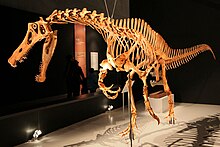
| |
| Reconstructed skeleton at the National Museum of Nature and Science, Tokyo. The postcranium is based on remains that cannot be confidently attributed to the animal. | |
| Scientific classification | |
| Domain: | Eukaryota |
| Kingdom: | Animalia |
| Phylum: | Chordata |
| Clade: | Dinosauria |
| Clade: | Saurischia |
| Clade: | Theropoda |
| Family: | †Spinosauridae |
| Subfamily: | † Spinosaurinae
|
| Genus: | †Irritator Martill et al., 1996 |
| Type species | |
| †Irritator challengeri Martill et al., 1996
| |
| Synonyms | |
| |
Irritator is a
Some paleontologists regard Angaturama limai—known from a snout tip that was described later in 1996—as a potential
Estimated at between 6 and 8 meters (20 and 26 ft) in length, Irritator weighed around 1 tonne (1.1 short tons), making it one of the smallest spinosaurids known. Its long, shallow and slender snout was lined with straight and unserrated conical teeth. Lengthwise atop the head ran a thin sagittal crest, to which powerful neck muscles were likely anchored. The nostrils were positioned far back from the tip of the snout, and a rigid secondary palate on the roof of the mouth would have strengthened the jaw when feeding. Belonging to a subadult, Irritator challengeri's holotype remains the most completely preserved spinosaurid skull yet found. The Angaturama snout tip expanded to the sides in a rosette-like shape, bearing long teeth and an unusually tall crest. One possible skeleton indicates it, like other spinosaurids, had enlarged first-finger claws and a sail running down its back.
Irritator had been mistaken initially for a
History of research
The holotype of Irritator was excavated from a chalk
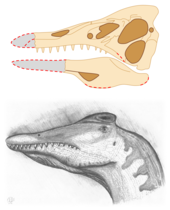
The skull was flattened sideways somewhat and, as is common with fossils, was partly crushed. The right side was well preserved, while the left was extensively damaged during collection. Some of the skull's hindmost upper surface had eroded, and the lower jaw lacked its front end, both owing to breakage during fossilization. Parts of the specimen were also cracked due to being part of a septarian
When Martill and colleagues first described Irritator challengeri, the holotype was still extensively encased in
Although the site of discovery is uncertain, the specimen most probably stems from the
Synonymy with Angaturama
Angaturama limai, another

In 1997, British paleontologists Alan J. Charig and Angela C. Milner considered Angaturama a likely junior synonym of Irritator, noting that both genera had retracted nostrils, long jaws, and characteristic spinosaurid dentition.[15] Paul Sereno and colleagues in 1998 agreed with this possibility, and additionally observed that the holotype of Angaturama seems to complete that of Irritator (meaning that they could belong to the same specimen).[16] Authors including Éric Buffetaut and Mohamed Ouaja in 2002,[17] Cristiano Dal Sasso and colleagues in 2005,[13] Tor G. Bertin in 2010,[18] Darren Naish in 2013,[19] and Madani Benyoucef and colleagues in 2015 supported this conclusion.[20] In their redescription of Irritator, Sues and colleagues pointed out that both holotypes are equally as narrow, and share transversely round teeth with defined yet unserrated edges. They also noted that a sagittal crest on Angaturama's premaxillae may correspond with that of Irritator's nasal bones.[7] Some objection has been raised to these assertions. Kellner and Campos in 2000 and Brazilian paleontologist Elaine B. Machado and Kellner in 2005 expressed the opinion that the fossils come from two different genera, and that the holotype of Angaturama limai was clearly more laterally flattened than that of Irritator challengeri.[2][21]
A review of both fossils by the Brazilian paleontologists Marcos A. F. Sales and Cesar L. Schultz in 2017 noted that the specimens also differ in other aspects of their preservation: the Irritator specimen is brighter in color and is affected by a vertical crack, while the Angaturama specimen bears many cavities; the damage to the teeth of the Irritator challengeri holotype is also much less severe. Sales and Schultz also identified a possible point of overlap, the third left maxillary tooth, and observed that the skull of Angaturama could have been larger than that of Irritator based on the proportions of the closely related genus
Postcranial material and additional finds
Besides the skull, the snout fragment, and some isolated teeth, the Romualdo Formation has also yielded
Some of the Romualdo Formation postcrania were used as the basis for the creation of a replica Angaturama skeleton, later mounted at the Federal University-owned Museu Nacional do Rio de Janeiro (
Description

Even by maximal size estimates, Irritator was smaller than other known spinosaurids.
Anatomy of the Irritator challengeri holotype
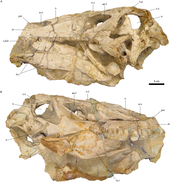
The holotype skull of Irritator challengeri, although heavily damaged in certain places, is largely complete; missing only the tip of the snout and the front of the
A thin

Irritator had straight or only faintly recurved conical teeth, bearing sharply defined but unserrated edges. Flutes (lengthwise ridges) were present on its tooth crowns, a common dental trait among spinosaurids.
Anatomy of the Angaturama limai holotype

The holotype of Angaturama limai consists only of the front part of the upper jaw, comprising the tips of the paired premaxillae and the frontmost ends of the maxillae. The specimen measures 19.2 cm (7.6 in) in height and 11 cm (4.3 in) in length, with the width of the palatal region being 4 to 5 mm (0.16 to 0.20 in). The suture between the maxilla and premaxilla was jagged at the front and straightened out towards the rear. The lower margin of the premaxillae was concave, with the concavity reaching its apex at the sixth premaxillary tooth. The front of the snout was expanded, forming the spoon-shaped terminal rosette characteristic of spinosaurids. This concave underside of the premaxillae would have complemented a convex and enlarged mandible tip.[14] The premaxillae connected with each other on the bottom to form Angaturama's secondary palate, which was also partially contributed to by two processes extending from the maxillae.[11] The snout was strongly compressed laterally, and the premaxillae gently tapered towards the top to form a tall sagittal crest 1 to 2 mm (0.039 to 0.079 in) in thickness. This crest was larger and extended farther forwards on the snout than in other known spinosaurids. The frontmost upper border of the premaxilla had a small bulge that overhung the base of the crest. This bulge was apparently damaged on its upper surface, indicating that the top of the crest may have extended even farther over and forwards from that point. The front of Angaturama's snout hence had a vertically straight or concave margin, atypical from the more smoothly sloping snouts of other spinosaurs.[11][14]
In the premaxilla, a broken-off tooth with partial tooth crown was recovered. The strongly extended and straight teeth with unserrated conical crowns, which measured 6 to 40 mm (0.24 to 1.57 in) in length, were singly embedded. This indicates continuous tooth replacement where new teeth were pushed up between the old ones. Judging by the alveoli (tooth sockets), the premaxilla had seven teeth altogether, the third tooth being the largest. The frontmost three teeth of the maxilla were also preserved. The premaxillary teeth increased in size from the first to third, shrank from the third to the sixth, and enlarged again from the sixth premaxillary to third maxillary positions. A 16 cm (6.3 in) diastema (gap in tooth row) was present between the last premaxillary and first maxillary tooth.[14]
Postcrania
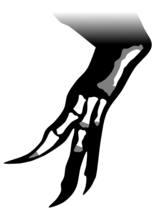
Though no skeletal remains were discovered with the original Angaturama snout tip, one partial skeleton (MN 4819-V) from a different location may belong to the genus.
The
Classification
Martill and his team originally classified Irritator as a
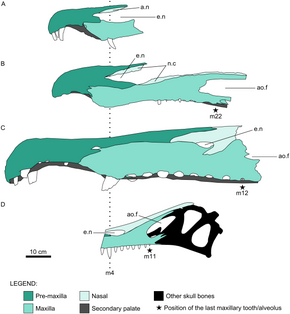
In 1998, Sereno and colleagues defined two subfamilies within the Spinosauridae based on craniodental (skull and tooth) characteristics. They were Spinosaurinae, where they placed Spinosaurus and Irritator; and Baryonychinae, to which they assigned Baryonyx, Suchomimus, and
Irritator is further distinguished from Baryonyx, Suchomimus, and Cristatusaurus by having slightly over half as many teeth in the maxilla, and from Spinosaurus due to its comparatively larger and more forwardly positioned nostril openings, which, unlike in Spinosaurus, are also formed by the premaxilla. The narrow sagittal crest, which ends in a knob-like process above the frontals, is another autapomorphy separating Irritator from other spinosaurids.[11] Although Angaturama limai's snout is generally narrower than in other spinosaurids, this might be due to damage sustained by the fossil; the holotype appears partly crushed and broken on its lower margin, with some of the preserved teeth having been sectioned off along their length. Therefore, Angaturama's only valid autapomorphy is its sagittal crest, which extends farther forwards on the rostrum and is more exaggerated than in other known spinosaurid skulls.[11][49]
Paleobiology
Diet and feeding

In 1996, Martill and colleagues theorized that Irritator challengeri, with its elongated snout and unserrated conical teeth, likely had at least a partly
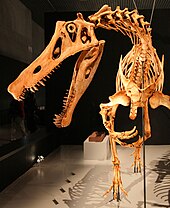
Irritator shared with crocodilians a stiff secondary palate and reduced antorbital fenestrae. In 2007, a
Another trait spinosaurs shared with gharials was an enlarged snout tip that wielded a rosette-shaped array of interlocking teeth, adept for impaling and catching fish.
Examinations and digital reconstructions of Irritator published in 2023 by Schade, Rauhut et al., suggests that the lower jaws of this spinosaurid could rotate and open laterally, with a gape similar to that of modern pelicans; this would have allowed the theropod to swallow very large prey items. It was also discovered to have a very weak but rapid bite as a result of this analysis. The study also reaffirms that Irritator likely possessed binocular vision and would have held its snout at an inclined orientation. Additionally, the examinations reaffirmed classification of spinosaurids as megalosauroids and that megalosauroids and allosauroidea were part of a monophyletic Carnosauria, with Monolophosaurus standing as a sister taxon to spinosauridae.[22]
Aquatic habits
Many spinosaurs likely had semiaquatic habits, as has been shown in studies using techniques like isotope analysis and bone histology. It has been found that they probably took advantage of aquatic prey and environments (usually marginal and coastal habitats[57]) to occupy a distinct ecological niche, therefore avoiding competition with more terrestrial theropods.[58][59] Spinosaurines appear to have been more adapted for such lifestyles than baryonychines.[23][60] A 2018 study by British paleontologist Thomas M. S. Arden and colleagues examined the morphology of spinosaurine skull bones for possible aquatic traits. They found that the frontal bones of Irritator, Spinosaurus, and Sigilmassasaurus were similar in being arched, concave on top, and narrowed at the front; features that would have resulted in the eyes being positioned further up on the head than in other theropods. In particular, the broad lower jaw and narrowed frontals of Irritator resulted in the orbits facing at a steep incline towards the midline of the skull, whereas most theropods had laterally facing orbits. These traits would have permitted the animal to see above the waterline when submerged.[61]
In 2018, Aureliano and colleagues conducted an analysis on the Romualdo Formation tibia fragment. CT scanning of the specimen in the
Neuroanatomy and senses
In 2020, German paleontologist Marco Schade and colleagues analyzed the anatomy of the holotype skull braincase through CT scans, revealing numerous details about behavioral capabilities of Irritator. With the scans, they created a 3D model of the skull and braincase, discovering that Irritator had elongated olfactory tracts and a relatively large floccular recesses (area that pierces through the semicircular canals and connects the brain with the inner ear). The
Both floccular recesses and semicircular canal suggest that Irritator could coordinate fast head movements and had a downward inclined snout posture, enabling an unobstructed, stereoscopic forward vision, which is important for distance perception and therefore precise snatching movements of the snout. These inferences seem to be an agreement with a piscivore life-style. They also noted that the relatively well-developed cochlear duct may have enable an average hearing frequency of 1,950 Hz with a frequency band width of 3,196 Hz. However, they considered these ranges as rough estimates and established an overall frequency range of 350–3,550 Hz, making Irritator to be placed under bird hearing but above crocodiles.[64]
Paleoenvironment and paleobiogeography

Irritator and Angaturama are known from the
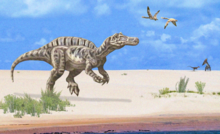
This environment was dominated by pterosaurs, including:

Similarities between the fauna of the Romualdo and Crato Formations to that of Middle Cretaceous Africa suggest that the Araripe Basin was connected to the
Taphonomy
The taphonomy (changes between death and fossilization) of the Irritator challengeri holotype specimen has been discussed by some researchers. The skull was found lying on its side. Preceding fossilization, several bones from the back of the braincase, as well as the dentary, splenial, coronoid, and right angular bones from the lower jaw, were lost. Other bones, mostly from the skull rear, had become disarticulated and displaced towards alternate regions of the head before burial.[7] Naish and colleagues in 2004 asserted that the Romualdo Formation dinosaur fauna is represented by animals that died near shorelines or rivers before being carried out to sea, where their floating remains were eventually fossilized.[42] In 2018, Aureliano and colleagues argued against this scenario, stating that the Irritator challengeri holotype's mandible was preserved in articulation with the rest of the skull, whereas it would have likely detached had the carcass been floating at sea. They also noted that the corpse would have quickly sunk due to the osteosclerosis of the skeleton. The researchers, therefore, concluded that fossils from the Santana Group represent organisms that were buried in their natural habitat, instead of having been deposited allochthonously (other than at their present position).[23]
References
- ^ S2CID 131339386.
- ^ ISSN 0101-9759.
- OCLC 62384519.
- OCLC 227315325.
- OCLC 63835422.
- OCLC 428131451.
- ^ S2CID 131050889.
- ^ ISSN 0266-6979.
- PMID 24598620.
- S2CID 247538712.
- ^ PMID 29107966.
- ^ S2CID 85354215.
- ^ S2CID 85702490.
- ^ .
- ^ Charig, A.J.; Milner, A.C. (1997). "Baryonyx walkeri, a fish-eating dinosaur from the Wealden of Surrey". Bulletin of the Natural History Museum of London. 53: 11–70. Archived from the original on November 17, 2015. Retrieved October 14, 2018.
- PMID 9812890.
- (PDF) from the original on January 22, 2015. Retrieved October 14, 2018.
- ^ Bertin, Tor (December 8, 2010). "A catalogue of material and review of the Spinosauridae". PalArch's Journal of Vertebrate Palaeontology. 7. Archived from the original on September 18, 2018. Retrieved September 13, 2018.
- ^ a b c d e f Naish, Darren (2013). "Brilliant Brazilian spinosaurids". Scientific American Blog Network. Archived from the original on October 1, 2018. Retrieved September 30, 2018.
- ISSN 0195-6671.
- ^ PMID 11151018.
- ^ S2CID 258649428.
- ^ S2CID 134353898.
- ^ a b Bittencourt, Jonathas; Kellner, Alexander (January 1, 2004). "On a sequence of sacrocaudal theropod dinosaur vertebrae from the Lower Cretaceous Santana Formation, northeastern Brazil". Arq Mus Nac. 62: 309–320.
- ^ a b c d e f g Machado, E.B.; Kellner, A.W.A.; Campos, D.A. (2005). "Preliminary information on a dinosaur (Theropoda, Spinosauridae) pelvis from the Cretaceous Santana Formation (Romualdo Member) Brazil". Congresso Latino-Americano de Paleontologia de Vertebrados. 2 (Boletim de resumos): 161–162.
- ^ a b c Kellner, A.W.A. (2001). "New information on the theropod dinosaurs from the Santana Formation (Aptian-Albian), Araripe Basin, Northeastern Brazil". Journal of Vertebrate Paleontology. 21 (supplement to 3): 67A.
- ^ a b Sales, Marcos (2017). Contribuições à paleontologia de Terópodes não-avianos do Mesocretáceo do Nordeste do Brasil (PhD thesis) (in Portuguese). Vol. 1. Universidade Federal do Rio Grande do Sul. p. 54. Archived from the original on October 1, 2018. Retrieved September 30, 2018.
- ^ Sayão, Juliana; Saraiva, Antonio; Silva, Helder; Kellner, Alexander (2011). "A new theropod dinosaur from the Romualdo Lagerstatte (Aptian-Albian), Araripe Basin, Brazil". Journal of Vertebrate Paleontology. 31: supplement 2: 187.
- PMID 24598620.
- ^ a b c d e O Estado de S. Paulo (in Portuguese), 2009-05-14, available at [1] Archived January 14, 2010, at the Wayback Machine; O Globo, 2009-05-15, abridgement available at [2] Archived May 20, 2009, at the Wayback Machine; University's announcement at Moutinho, Sofia (November 5, 2009). "Inaugura dia 14 a exposição Dinossauros no Sertão". Archived from the original on July 6, 2011. Retrieved January 13, 2010.
- ^ Naish, Darren. "In Rio for the 2013 International Symposium on Pterosaurs". Scientific American Blog Network. Archived from the original on October 7, 2018. Retrieved October 7, 2018.
- (PDF) from the original on August 18, 2017. Retrieved September 15, 2018.
- ^ Belam, Martin (September 3, 2018). "Brazil's national museum: what could be lost in the fire?". The Guardian. Archived from the original on September 4, 2018. Retrieved October 15, 2018.
- ^ Lopes, Reinaldo José (September 2018). "Entenda a importância do acervo do Museu Nacional, destruído pelas chamas no RJ". Folha de S.Paulo (in Brazilian Portuguese). Archived from the original on September 3, 2018. Retrieved September 3, 2018.
- ^ Paul, G.S. (2010). The Princeton Field Guide to Dinosaurs. Princeton University Press. p. 87.
- ^ Holtz, Thomas R. Jr. (2011). "Winter 2010 Appendix" (PDF). Dinosaurs: The Most Complete, Up-to-Date Encyclopedia for Dinosaur Lovers of All Ages.
- ^ Holtz, T.R. Jr. (2014). "Supplementary Information to Dinosaurs: The Most Complete, Up-to-Date Encyclopedia for Dinosaur Lovers of All Ages". University of Maryland. Archived from the original on November 2, 2014. Retrieved September 5, 2014.
- ISBN 978-1-84696-988-1.
- ^ S2CID 90952478.
- ^ S2CID 85854809.
- ^ Machado, E.B.; Kellner, A.W.A. (2008). "An overview of the Spinosauridae (Dinosauria, Theropoda) with comments on the Brazilian material". Journal of Vertebrate Paleontology. 28(3): 109A.
- ^ S2CID 18592288.
- S2CID 2986017.
- PMID 28463233.
- ^ Kellner, A.W.A. (1996). "Remarks on Brazilian dinosaurs". Memoirs of the Queensland Museum. 39 (3): 611–626. Archived from the original on October 24, 2018. Retrieved October 24, 2018.
- ISBN 978-0-901702-79-1.
- ^ Holtz, Thomas; Molnar, Ralph E.; Currie, Philip (June 12, 2004). "Basal Tetanurae". The Dinosauria: Second Edition. University of California Press. pp. 71–110. Retrieved September 25, 2018.
- ^ PMID 9812890.
- S2CID 85354215.
- S2CID 22646156.
- ^ PMID 23724135.
- S2CID 85854809.
- PMID 26500829.
- ^ Milner, Andrew; Kirkland, James (2007). "The case for fishing dinosaurs at the St. George Dinosaur Discovery Site at Johnson Farm". Utah Geological Survey Notes. 39 (3): 1–3.
- from the original on October 24, 2018. Retrieved October 24, 2018.
- S2CID 4398855.
- PMID 26829315.
- doi:10.1130/G30402.1.
- PMID 29643213.
- ^ S2CID 34421257.
- from the original on October 23, 2018. Retrieved October 22, 2018.
- ^ Witmer, L.M. 1995.The Extant Phylogenetic Bracket and the Importance of Reconstructing Soft Tissues in Fossils. in Thomason, J.J. (ed). Functional Morphology in Vertebrate Paleontology. New York. Cambridge University Press. pp. 19–33.
- PMID 30128195.
- ^ PMID 32518236.
- S2CID 45430990.
- S2CID 90477315.
- ISSN 0031-0182.
- ^ from the original on September 5, 2018. Retrieved September 4, 2018.
- ^ Barrett, Paul; Butler, Richard; Edwards, Nicholas; Milner, Andrew R. (December 31, 2008). "Pterosaur distribution in time and space: An atlas". Zitteliana Reihe B: Abhandlungen der Bayerischen Staatssammlung für Paläontologie und Geologie. 28: 61–107. Archived from the original on September 5, 2018. Retrieved September 4, 2018.
- S2CID 30685981.
- .
- ISSN 0195-6671.
- S2CID 129166567.
- from the original on September 20, 2018. Retrieved September 29, 2018.
- S2CID 59449305.
- from the original on October 1, 2018. Retrieved September 29, 2018.
- S2CID 45417065.
- ISSN 0031-0182.
- ^ a b Brito, Paulo; Yabumoto, Yoshitaka (2011). "An updated review of the fish faunas from the Crato and Santana formations in Brazil, a close relationship to the Tethys fauna". Bulletin of Kitakyushu Museum of Natural History and Human History, Ser. A. 9. Archived from the original on September 25, 2018. Retrieved September 6, 2018.
- ISSN 0567-7920.
- ISSN 0895-9811.
- S2CID 2647367.
- .
